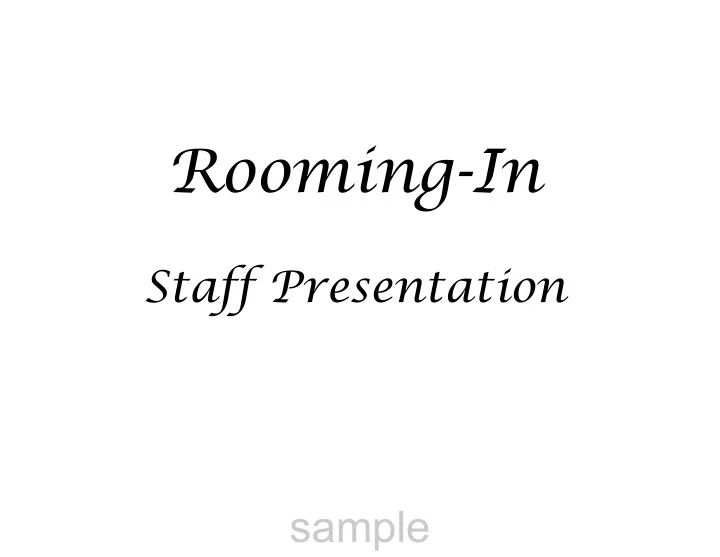

Rooming-In Staff Presentation sample
Rooming-In • What Is It? – Caring for mother and baby together; minimizing unnecessary separation • Why Are We Doing It? – Because we believe, and research supports that the best place for baby is with mother sample
Rooming In Endorsed by : • American Congress of OB-GYN (ACOG) • Academy of Breastfeeding Medicine (ABM) • Assoc. of Women’s Health, OB & Neonatal Nurses (AWHONN) • International Lactation Consultant Assoc. (ILCA) • World Health Organization (WHO) • United Nations Children’s Fund (UNICEF) • American Academy of Pediatrics (AAP) • American Academy of Family Practice (AAFP) • CDC – mPINC Quality Practice Measure • JCAHO – BF Exclusivity as a core measure sample
Step #7 Baby Friendly Hospital Initiative Practice rooming-in – allow mothers and infants to remain together 24 hours a day sample
Parents are the most important caregivers for their baby. Parents have a right to participate in the planning of their baby’s care. sample
Research Shows A baby in mother's room will: • Cry less • Maintain more stable body temperature • Encourage mother's mature breast milk to come in sooner • Stay healthier and have a lower incidence of infant cross-infection sample
Research Shows A mother who has her baby with her will: • Learn more about her baby’s normal responses and sleep-wake cycle • Bond more easily with her baby • Be more successful at breastfeeding • Be more confident sample
Nurses as Role Models & Teachers for Parents • We help to model ways for parents to care for their baby – Changing diapers, swaddling, bathing • We help to model ways for parents to relate to their baby – How to soothe, what to do when baby cries • We help parents to understand their baby’s behaviors – What to do when baby sneezes, hiccups, normal reflexes sample
People Retain • 10% of what they READ • 20% of what they HEAR • 30% of what they SEE • 50% of what they SEE & HEAR • 90% of what they DISCUSS & PARTICIPATE IN sample
Care for Baby in Mom’s Room • Bath • Nursing Assessments • Pediatrician Assessments • Vital signs • Weights • Hearing Screening • Medications • Labs sample
Ways To Encourage Rooming-In • Educate Parents Prenatally & on Admission • “Better for Baby” • “Ring your light, I’m here for you” • Naps during the day • Limit visitors • Help dad to learn comfort techniques • Do not offer separation • “Just like you will at home…..” sample
“I f we're growing, we're always going to be out of our comfort zone.” sample
References • Lowe, N. (2007). Highlights of Listening to Mothers II Survey. JOGNN. 36 (1), 1-2 • Mullen, K., Conrad, L., Hoadley, G., Iannone, D. (2007). Family-Centered Maternity Care: One Hospital’s Quest for Excellence. Nursing for Women’s Health. 11 (3), 282-290 • Petersen, M.F., Cohen, J., Parsons, V.(2004). Family-Centered Care: Do We Practice What we Preach? JOGNN, 33 (4), 421-427 • Phillips, C. (2003). Family-Centered Maternity Care. Sudbury, MA: Jones and Bartlett. sample
Recommend
More recommend